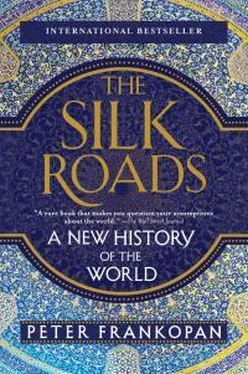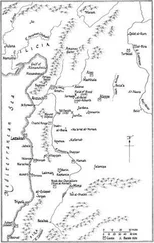The sums paid in return for peace were substantial. In 1 BC, for example, the Xiongnu were given 30,000 rolls of silk and a similar amount of raw material, as well as 370 items of clothing.41 Some officials liked to believe that the tribe’s love of luxury would prove its undoing. “Now [you have] this fondness for Chinese things,” one envoy brashly told a tribal leader. Xiongnu customs were changing, he said. China, he predicted confidently, “will in the end succeed in winning over the whole Xiongnu nation.”42
This was wishful thinking. In fact, the diplomacy that maintained peace and good relations took a toll both financially and politically: paying tribute was expensive and a sign of political weakness. So in due course the Han rulers of China resolved to deal with the Xiongnu once and for all. First, a concerted effort was made to take control of the agriculturally rich western regions of Xiyu; the nomads were driven back as the Chinese took control of the Gansu corridor in a decade-long series of campaigns that ended in 119 BC. To the west lay the Pamir mountains and, beyond them, a new world. China had opened a door leading on to a trans-continental network; it was the moment of the birth of the Silk Roads.
The expansion of China saw a surge of interest in what lay beyond. Officials were commissioned to investigate and write reports about the regions beyond the mountains. One such account survives as the Shi Ji (Historical Records), written by Sima Qian, son of the imperial court’s Grand Historian ( Taishi ), who continued to work on this account even after he had been disgraced and castrated for daring to defend an impetuous young general who had led troops to defeat.43 He carefully set out what he had been able to discover about the histories, economies and armies of the peoples in the Indus valley, Persia and Central Asia. The kingdoms of Central Asia were weak, he noted, because of pressure from nomads displaced by Chinese forces who had turned their attention elsewhere. The inhabitants of these kingdoms were “poor in the use of arms,” he wrote, “but clever at commerce,” with flourishing markets in the capital Bactra, “where all sorts of goods are bought and sold.”44
Trade between China and the world beyond developed slowly. Negotiating the routes along the edge of the Gobi desert was not easy, especially beyond the Jade Gate, the frontier post past which caravans of traders travelled on their way west. Passing from one oasis to another across treacherous terrain was difficult whether their route took them through the Taklamakan desert or through the passes of the Tian Shan mountains or through the Pamirs. Extremes of temperature had to be negotiated—one reason why the Bactrian camel was so valued. Hardy enough to brave the harsh conditions of the desert, these animals have advance knowledge of deadly sandstorms, one writer observed, and “immediately stand snarling together”—a sign for the traders and caravan leaders to “cover their noses and mouths by wrapping them in felt.” The camel was clearly a fallible weathervane, however; sources talk of passing large numbers of dead animals and skeletons along the routes.45 In such tough circumstances, rewards had to be high for the risks to be worth taking. Although bamboo and cloth made in Sichuan could be found for sale thousands of miles away in the markets of Bactria, it was primarily rare and high-value goods that were transported over long distances.46
Chief among these was the trade in silk. Silk performed a number of important roles in the ancient world apart from its value to nomadic tribes. Under the Han dynasty, silk was used alongside coins and grain to pay troops. It was in some ways the most reliable currency: producing money in sufficient quantities was a problem, as was the fact that not all of China was fully monetised; this presented a particular difficulty when it came to military pay since theatres of action were often in remote regions, where coins were all but useless. Grain, meanwhile, went rotten after a time. As a result, bolts of raw silk were used regularly as currency, either as pay or, as in the case of one Buddhist monastery in Central Asia, as a fine for monks who broke the foundation’s rules.47 Silk became an international currency as well as a luxury product.
The Chinese also regulated trade by creating a formal framework for controlling merchants who came from outside territories. A remarkable collection of 35,000 texts from the garrison town of Xuanquan, not far from Dunhuang, paints a vivid picture of the everyday goings-on in a town set at the neck of the Gansu corridor. From these texts, written on bamboo and wooden tablets, we learn that visitors passing into China had to stick to designated routes, were issued with written passes and were regularly counted by officials to ensure that all who entered the country also eventually made their way home. Like a modern hotel guest folio, records were kept for each visitor, noting how much they spent on food, what their place of origin was, their title and in which direction they were headed.48
These measures are to be understood not as a form of suspicious surveillance, but rather as a means of being able to note accurately who was entering and leaving China, as well as what they were doing there, and above all to record the value of the goods that were bought and sold for customs purposes. The sophistication of the techniques and their early implementation reveal how the imperial courts at the capital in Chang’an (modern Xi’an) and from the first century AD at Luoyang dealt with a world that seemed to be shrinking before their eyes.49 We think of globalisation as a uniquely modern phenomenon; yet 2,000 years ago too, it was a fact of life, one that presented opportunities, created problems and prompted technological advance.
* * *
As it happened, developments many thousands of miles away served to stimulate demand for luxury items—and the ability to pay for them. In Parthia, the descendants of Seleucus were deposed around 247 BC by one Arsaces, a man whose background is obscure. His descendants, known as the Arsacids, consolidated their hold on power and then set about extending it across western Asia into Persia, skilfully expropriating history to fuse Greek and Persian ideas into an increasingly coherent and robust new identity. The result was a time of stability and prosperity.50
But it was what was happening in the Mediterranean that provided the greatest stimulus of all. A small town in an unpromising location halfway up the west coast of Italy had slowly managed to turn itself from a provincial backwater into a regional power. Taking over one coastal city-state after another, Rome came to dominate the western Mediterranean. By the middle of the first century BC, its ambitions were expanding dramatically. And attention was focused firmly on the east.
Rome had evolved into an intensely competitive state, one that glorified the military and acclaimed violence and killing. Gladiatorial games were the bedrock of public entertainment, a place where mastery over foreign peoples and over nature was brutally celebrated. Triumphal arches all over the city provided daily reminders of military victories to its bustling population. Militarism, fearlessness and the love of glory were carefully cultivated as the key characteristics of an ambitious city whose reach was stretching forever further.51
The backbone of Roman power was the army, honed and conditioned to demanding standards. Soldiers were expected to be able to march more than twenty miles in five hours, hauling at least fifty pounds of equipment with them at the same time. Marriage was not only frowned on but specifically prohibited in order to keep recruits bonded to each other. Corps of highly trained, fit and intense young men who had been brought up confident in their ability and assured of their destiny were the rock on which Rome was built.52
Читать дальше











